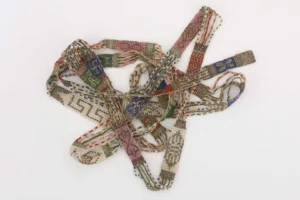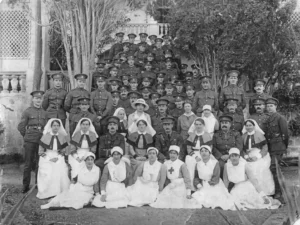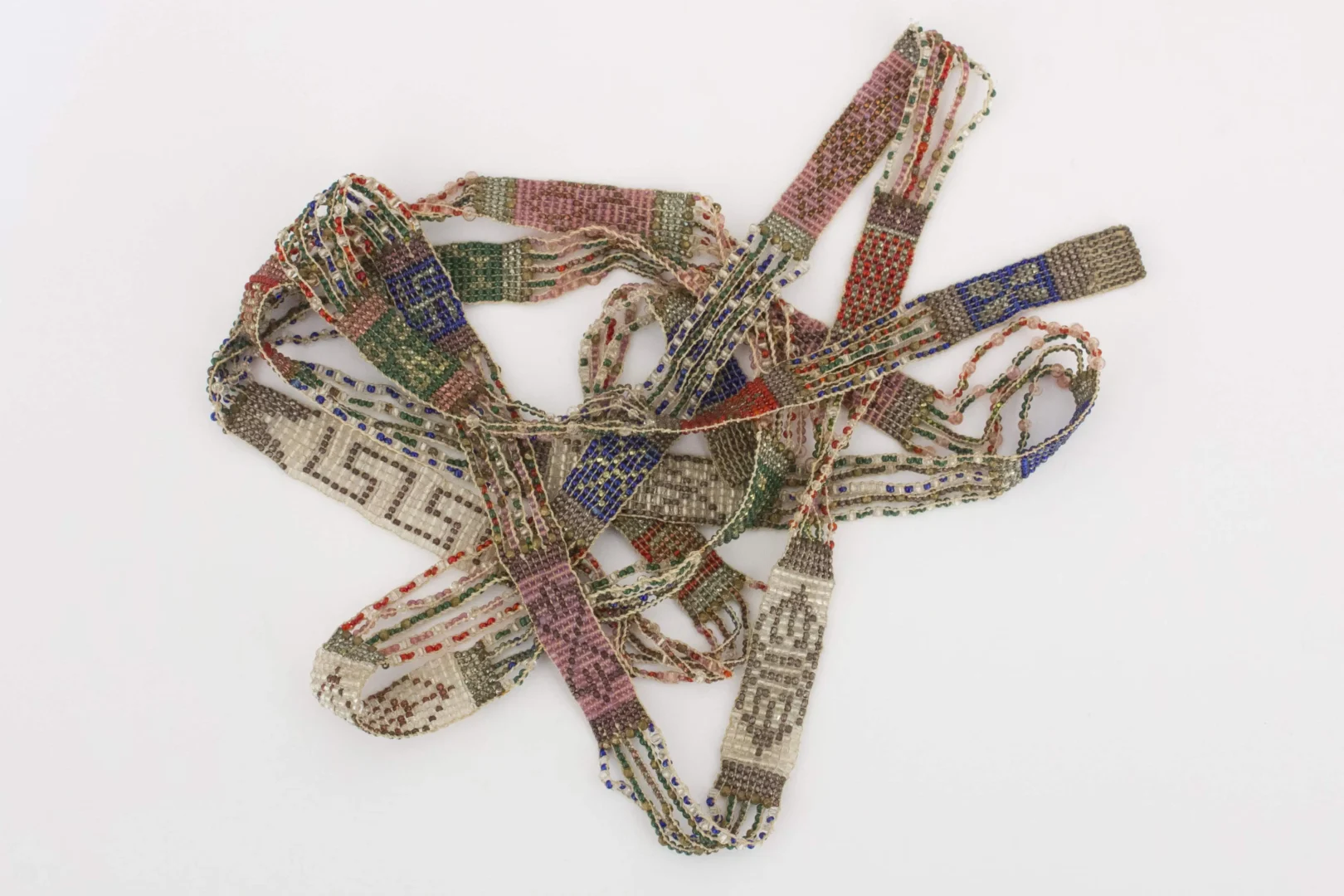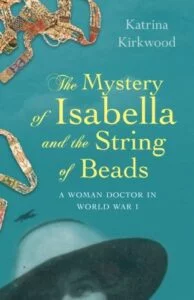In our occasional #WritersWednesday series about what motivates us to write on our chosen topics in our preferred genres, creative non-fiction author Katrina Kirkwood explains how she arrived at the best way to tell the mysterious story behind a single artefact: a family heirloom necklace.
My Jumping Off Point: A Family Mystery
My writing began from my attempt to solve a double mystery. Was there any truth in the story that my grandmother, Isabella, had served as a doctor during WW1? And had the strange string of beads that tangled amongst her medical instruments really been given to her by a grateful German prisoner of war?
The research went well. Unexpected documents appeared from cyberspace and helpful archivists produced trophies from their vaults, yet as my computer filled with files and data swirled around my mind, I found myself an unwilling curator. I could see that the story would interest people well beyond the family – it represented the barely recorded history of the tiny group of women who, like Isabella, braved fierce opposition to serve as doctors in WW1 – but every detail I decided to ignore shaped the story and its accuracy just as much as the particulars I chose to include. How, exactly, was I to thread this surfeit of information into a true history?
Drawing on my Background as a Research Scientist

The initial inspiration: a string of her grandmother's beads
My own back story made it complicated. I had once been a research scientist. Should I dig out that old academic hat and compose a detailed treatise full of caveats and care?
I hesitated. Since I had worn that hat, I had become an artist, I had built installations exploring how much one person could put themselves into another person’s shoes and I had ended up working as a digital storyteller in the Welsh Valleys. There, my task had been to help all sorts of people make mini-films of their untold tales.
I had become obsessed with storytelling – if these silent voices were to be heard, their stories had to be told so dynamically that people were forced to stop and listen.
Best Way to Reach the Right Audience
So now, faced with a mass of material, how was I to get people to listen to Isabella’s untold tale? An academic treatise would reach very few people, but fiction was equally out of the question – the whole point of the story was that, however unlikely it seemed, it was true.
“Creative nonfiction,” advised somebody. A logical impossibility, I thought.
But I investigated. I began travelling. I risked letting scenes come alive – and my inner storyteller loved it.

But it was hard. With every painstaking sentence, I understood why biographies fill up with ‘might haves’, ‘could haves’ and ‘would haves’. My scientific side reacted fiercely, “How dare you describe those scenes? However much they make Isabella’s life more vivid, what about certainty? How can you be sure?”
The storyteller fought back just as ferociously, “One more ‘fact’ here, one new piece of information there and the whole tentative edifice deduced from your so-called-certainty would tumble.” That shut the scientist up – it had seen such collapses many times.
Doing What Felt Right
The storyteller danced a victory jig – it knew it would make mistakes, but it also firmly believed that stories and scenes got far closer to the heart of any matter than an agglomeration of facts dosed liberally with caveats.
In this case, it inched me nearer to my grandmother’s shoes, it made a story fit for general consumption and, as Salman Rushdie has said, “It felt like the truth.”
So, last July, I published the version of Isabella’s story that I had chosen to write. The trouble is that I have been hooked by words. I think of all those amazing people in the valleys – and the equally incredible people who live in every corner of the world. I want to return to helping people tell their untold stories – but this time, with dynamic words.
OVER TO YOU If you'd like to share your personal story about writing creative non-fiction, we'd love to hear about it.
Fascinating #story behind the story of @kkstories' book inspired by her grandmother's beads #ww Share on XFURTHER READING If you enjoyed this post, you'll also appreciate this contemplative post by another creative non-fiction author, Paul Murphy, about his own journey along this path:






[…] Why I Write What I Write – Creative Non-Fiction […]
[…] Why I Write What I Write – Creative Non-Fiction […]
[…] Why I Write What I Write – Creative Non-Fiction […]
[…] The Alliance of Independent Authors: Creative Non-Fiction Case Study | Self-Publishing Advice Center […]
Hi Patsy,
Same conundrum – how to make a really good, true, story accessible to the broad audience who might appreciate it. You’ve chosen a different solution from the one I chose, but that only goes to prove how many ways there are of telling a good tale. Sounds like a fascinating book.
Hi Patsy,
Same conundrum – how to make a real story into a page-turner that will carry a great story to the broad audience who would appreciate it. But you’ve chosen a different solution. It’s fascinating to see how many different ways there are working things out. It looks a really interesting book… I’m tempted…
Great Story Katrina, and being non-fiction, is even more exciting in it’s reality. You patterned the members of the Explorer’s Club, Richard Halliburton, Lowell Thomas, and the rest in the era of your grandmother’s necklace. When you start digging, you never now what will come of it. The unknown is always more exciting.
This precisely how i write my Fiction. I develop the premise, and the characters, and then let them write the novel. I just assist in the Research.
Best of success.
Warren.
Hi Warren, interesting to hear your working method. Sometimes it seems there’s more in common between fiction and nonfiction than we’ve been led to expect. They both demand good storytelling.
I published my first book last spring called The Temple Revealed in Creation: A Portrait of the Family—it was in the style of creative non-fiction. My “tribe” loved it and many are clamoring for more. I thought I had created a completely new genre, but apparently not. I was delighted to read your blog—it confirmed that this is a legitimate niche. I have DMIN in Hebraic Studies in Christianity and my area of expertise is the Temple in Jerusalem. I have been researching this topic for nearly 20 years and had amassed voluminous amounts of material. However, I didn’t want to write an academic tome because I knew no one would read it. I included what I call fictional vignettes in each chapter to help the material come alive. It worked and turned out to be my favorite part of the project. For example, one of the most important ceremonies in the Temple during the First Century was the Water Drawing ritual. I described the ceremony as if the reader were there – portraying the sights, sounds, and smells. So much better than plowing through the weeds. I’m currently working on the second volume The Temple Revealed in the Garden using the same format.
Hi Dinah,
That sounds really interesting. I first heard about Creative Nonfiction on a course at Ty Newydd in North Wales. When you look it up online, you’ll find all sorts of courses in it, but not many in the way of forums or places where people writing in that style can congregate and discuss the joys and tensions of using the genre. Best of luck.
What a wonderful story to dig out and share! But is it not available as an ebook?
Hi Jennifer, It’s available as an ebook – you should be able to find it on Amazon. I reduced the price yesterday, and kindle told me it was live, but maybe it’s being slow in your part of the world. It’s ok in the UK, so I hope you’ll be able to find it.
I faced the same conundrum writing about my four times great grandmother, who emigrated from Dorset to New South Wales in 1801, when it was a teen-age penal colony. With family history – any history come to that – it’s one thing to discover the where, what, when, who and how, and quite another to figure out the Why. So I dramatised scenes in which, for instance, the family debated the pros and cons of migration (a useful way to get a lot historical information over) and how they coped with living conditions in the new colony, building their own house and clearing their land etc. I did it to make the book more of a page-turner, especially for non family members, and as a way of writing about early Australian colonial history without it turning into a texr book. I managed to get rid of most of the ‘would haves’ by setting myself up as the storyteller right at the beginning giving her version of events. It took a while to get the tone right but I think – I hope – it worked in the end.